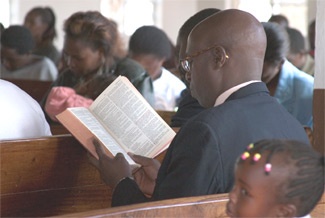|
|
The Bible changes lives. It cuts to the heart and creates new communities. In the pages of the Bible people meet God.
Many theological claims and scripture references could be advanced to describe the relationship between the Bible and church growth; however, from the practical perspective of a church worker or missionary, two points of impact are important.
- The micro level. At the level of an emerging congregation, the Bible is essential for follow-up. Bible study is at the center of the relationship-building, disciple-making fellowship that cements one’s commitment to the group called church.
- The macro level. A passion for the Bible precipitates and fuels movements of church planting and missionary sending.
To plant or grow a congregation, two basic things must repeatedly occur: people must come to know Jesus and they must become members of his body. The first step can happen in an evangelistic instant. It is the miracle of faith born during a gospel presentation. What follows is most effectively accomplished through an intentional program of Bible study. House churches, cell groups and small groups are used to incorporate new believers. At the center of each one is a time of Bible study. The obvious benefit of these groups is that the members gain knowledge of what the Bible says about faith and life (2 Peter 1:3); however, a number of other dynamics contribute to church planting and growth. Below are seven.
- The small group is a venue for seekers. It offers a low-threat environment into which a believer may invite friends or family members.
- The regularity of group meetings puts people in relationships.
- Scripture is the counselor and authority on “one-another” fellowship.
- The study group empowers ordinary believers to search and to share.
- The group is an incubator for new leaders.
- As an engine of growth, Bible study groups are infinitely reproducible by ordinary believers even in a context of opposition and persecution.
- Even in societies with low levels of literacy, public reading, storytelling or scripture recordings are at the center of gatherings that produce growth.

Two patterns seem to inhibit growth. Roland Allen calls the first “fear for the doctrine.”1 Here, the Bible is used to prooftext theological positions and ordinary people are not trusted to read or teach it. There will be no spontaneous expansion of the Church. A second danger is the elevation of individual “anointing” over the authority and perspicuity (clarity and ease in understanding) of scripture. Anointing often elevates an obscure verse for the personal benefit of the anointed one; this can lead to a cult of personality. In both cases, ordinary believers are convinced that the Bible is the province of experts beyond their ability to understand, much less share with others.
A respect for scripture is at the foundation for mass movements. There is extensive literature on revivals, people movements, church planting movements, apostolically-gifted people groups and global movements. In every case, observers remark on the importance of the Bible in founding, directing and strengthening large-scale change.
Where there are churches, revival often precipitates a passion for growth and mission sending. Donald McGavran identifies “thorough Bible study” as a precondition for revival: “Revivals in the churches of Europe and America were preceded by long years of careful Bible reading in homes and churches.”2 The Korean revival led to an explosive period of church planting worldwide.
People movements happen when the greater part of an entire ethnic group become Christ followers over a relatively short period of time. These movements often happen shortly after that group has access to the Bible in their own language for the first time. Committed translators such as Adoniram Judson, William Carey, William Cameron Townsend and their heirs continue to have a remarkable impact on church planting.
More recently, mission strategists have focused on geometric growth, church multiplication, Discipling A Whole Nation (DAWN) and church planting movements. In much of this literature, the small group Bible study is a strategic building block. In his survey of church planting movements, David Garrison observed that “in every instance, scriptures provided the rudder for the church’s life, and its authority was unquestioned.”3
Philip Jenkins notes that the Church appears to be growing most rapidly in places where the Bible is taken most literally.4 Where the Bible is taken literally, it is read, understood and lived by ordinary people. Where ordinary people are empowered, the Church grows. Isaiah 55:11 attests to this: “So is my word that goes out from my mouth: It will not return to me empty, but will accomplish what I desire and achieve the purpose for which I sent it.”
Endnotes
1. Allen, Roland. 1962. The Spontaneous Expansion of the Church. London: World Dominion Press.
2. McGavran, Donald. 1970. Understanding Church Growth. Grand Rapids, Michigan, USA: Eerdmans.
3. Garrison, David. Church Planting Movements. 2000. Richmond, Virginia, USA: International Missions Board of the Southern Baptist Convention.
4. Jenkins, Philip. 2006. The New Faces of Christianity: Believing the Bible in the Global South. New York, USA: Oxford University Press.

